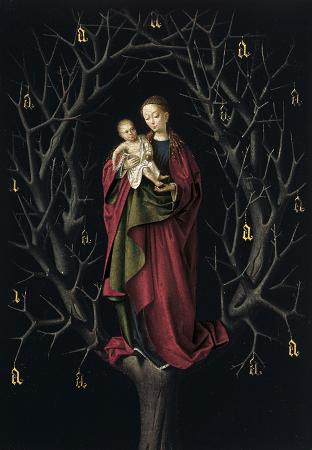Madonna of Dry Tree (c1462). Oil on panel. 17 x 12. Madonna of the Dry Tree is a small oil-on-oak panel painting dated c. 1462-1465 by the Early Netherlandish painter Petrus Christus. Unusually innovative and dramatic, it presents the Virgin Mary holding the Christ Child while standing on a disembodied dead tree trunk and surrounded by a crown of thorns. The painting's imagery is thought to be derive from the Book of Ezekiel, with the dry tree a symbol of the withered Tree of Knowledge in the Garden of Eden, brought to life by the Virgin and the birth of Christ. The 15 golden As hanging from the branches of the tree represent the first letter of the Angelic Salutation, the Ave Maria. The Christ Child holds an orb crowned with a cross. The iconography may draw from the Confraternity of Our Lady of the Dry Tree in Bruges, to which both Christus and his wife Gaudicine belonged. Mary is shown holding the Christ child in her arms. She is surrounded by thin, barren, branches, that reach around her to an oval arch. She wears long red robe with green lining, The folds of her dress cut into the form in an almost sculptural manner. Her robe closely resembles the dress in Christus's c. 1444 Exeter Madonna, leading to speculation that the painting was completed earlier than the usually assumed 1462-1465. Unusually for a Madonna of the time, her face is unidealised; her features are not soft nor rounded, and her expression less presupposing than in Christus's later Madonnas or even secular female portraits. Joel Upton writes of her that she is shown as a warm and human figure, very attractive, and yet serene and demure as the Mother of God. The representation of Christ seems derived from Rogier van der Weyden, especially in the playfulness and amiability of his facial expression, although given that Christus might not have had access to the older master's work, the influence may be second-hand, probably through the paintings of Hans Memling. The panel is highly illustionistic, perhaps on par with the older painter's Duran Madonna. Christus employs trompe-l'oeil techniques in a number of passages, creating a three-dimensional effect that adds to the strangeness and disembodied atmosphere. These can be most notably seen in the Virgin's hand as it lies below the child's toes, in the orb held in his hands, and in the golden letters hanging from the tree briars. X-radiography reveals little preparatory underdrawing outside of a series of ruled lines used to situate elements within the overall design. Maryan Ainsworth notes that this is typical of Christus's smaller panels, some which-including this work-could be considered miniatures, and compares it to the techniques used in contemporary illuminated manuscripts. Art historian Grete Ring connected the iconography to the Bruges confraternity of Our Lady of the Dry Tree. Christus joined the Confraternity of Our Lady of the Dry Tree sometime around 1462-63. Both confraternities were patronized by members of the upper echelon of Burgundian society; Philip the Good's wife Isabella of Portugal, as well as most of the leading Burgundian nobles, upper-class families and foreign traders of Bruges, such as the Portinaris. Christus joined-for the same reason Gerard David would some years later-to attract wealthy patrons. Philip the Good is believed to have established the confraternity after a successful battle against the French. Beforehand, he is said to have prayed to an image of the Virgin carved on a dry tree. Although the confraternity already existed, the story reveals the veneration of images of the Virgin carved on trees. The tradition of Marian images on trees, either suspended or carved, was a blend of pagan and Christian worship originating as early as the fifth century. Such trees were commonly found in crossroads, functioning as landscape markers. Our Lady of the Oak and Our Lady of the Cherry are others in the same tradition. It was first documented in 1396, but had probably been established earlier. Records show the Confraternity met in a private chapel, located in the Church of the Minorites which was destroyed during the Netherlandish Reformation in 1578. The work's iconography is both dramatic and highly unusual, and was described by Ainsworth as unprecedented in Netherlandish painting. The imagery may be derived from Ezekiel 17:24: and all the trees of the field shall know that I the Lord have brought down the high tree, have exalted the low tree, have dried up the green tree, and have made the dry tree to flourish. The painting seems to be a somewhat bitter representation of the Tree of Knowledge, but wilted and thorny. Art historians presume it represents a metaphor for original sin, and that presumably the tree will not return to life until the coming of Christ.
more...





